Triumph Street Triple 765 RS
120bhp – TFT display – Slipper clutch – Quickshifter
By Peter Elliott
Someone once said they never read a review that wasn’t glowing. It’s a point that has some validity; the reviewer should find the positives and the negatives and not set the bar so high that further improvements cannot be eclipsed. That judgement bar is an eternally rising measure of expectation, versus the (hopefully) constantly rising level of delivery.
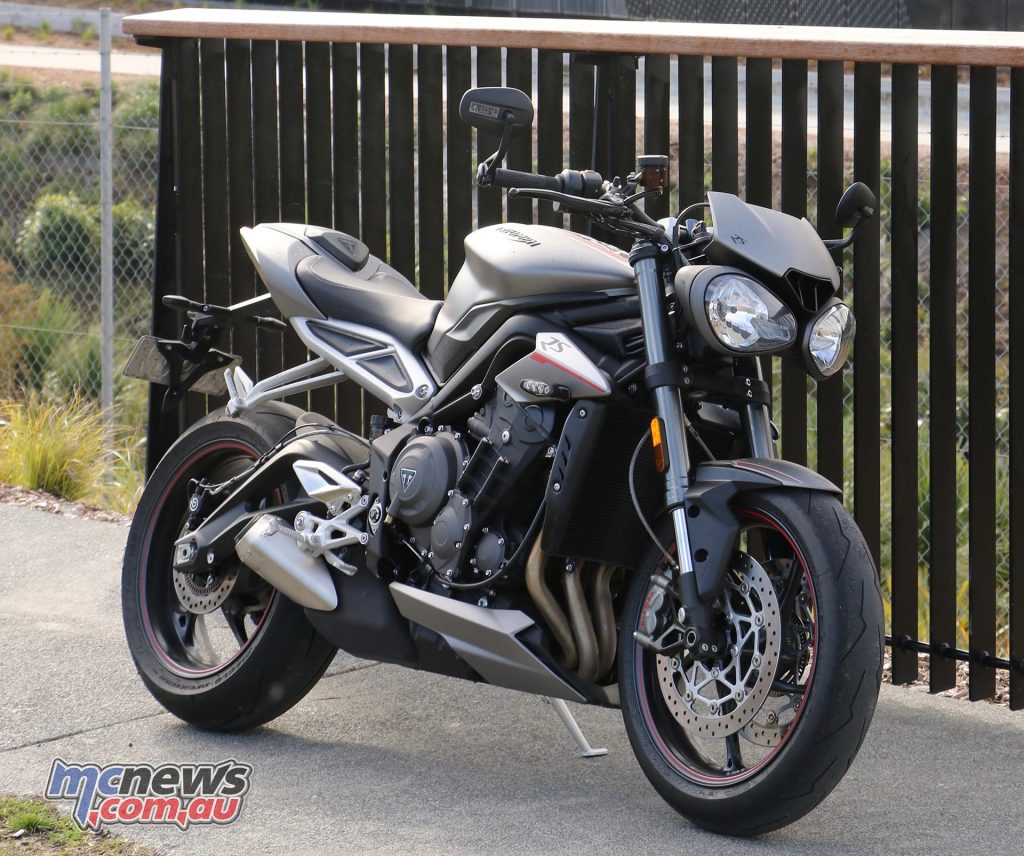
That said we are living in times when the disapproval crowd has some strong sway; electric versus petrol, eco versus raw grunt, emissions versus output, ad nauseum. So while the new Triumph Street Triple 765 range meets standards, it also pushes the limit of what is possible, and pushes it damn hard. So let’s damn well enjoy it while we can.
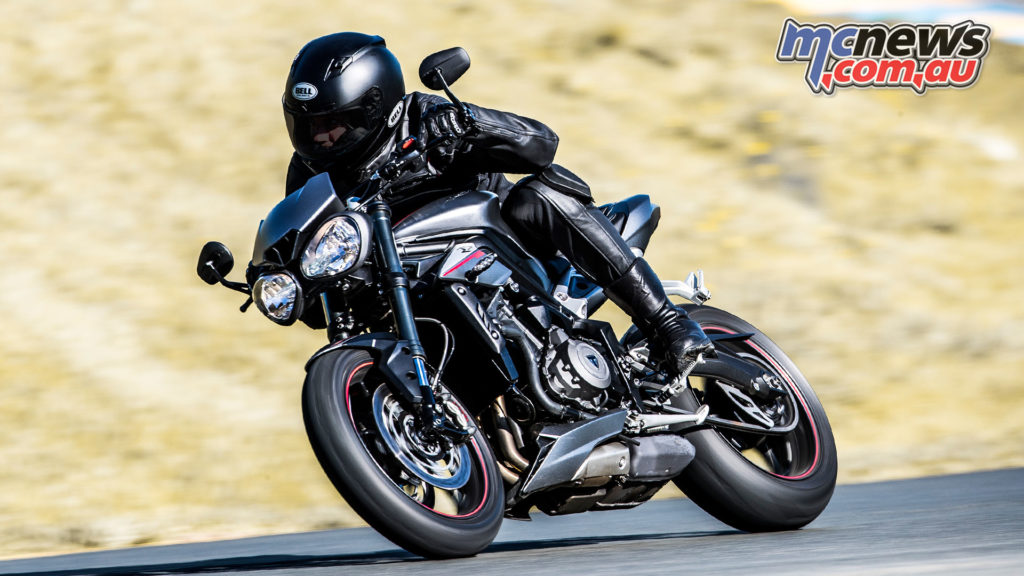
Simply put, the test motorcycle I took delivery of was bloody breathtaking. Derived from the bones of the former, well-loved, Daytona 675, the 765 Street Triple is an all-new radicalisation of the format.
Light at 166kg dry claimed, the screaming free-revving triple generates 121bhp (90.4kW also claimed) in the RS version, and the journey from five grand to 11-plus rpm in the gears is searingly quick. The speed-shifter takes gear changes from quick to imperceptible and the bike generates a wall of speed that thrills the soul, and also managed to shed thirty years of fatigue and worry from this particular rider. I rode this bike in fair weather and foul, I just couldn’t keep my paws off it.
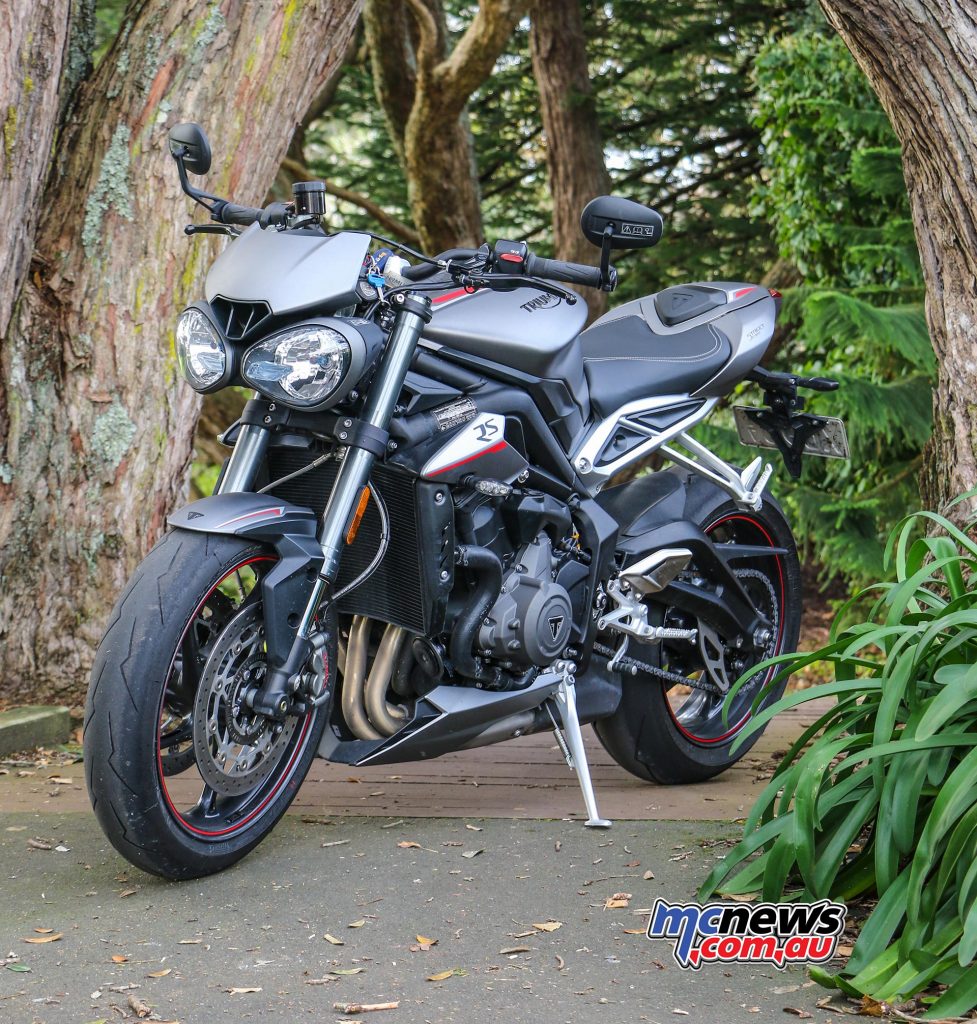
One recent Sunday afternoon I took some friends and a newbie rider through the local twisties, it had been pelting down, with lots of leaves and storm detritus on the road, and made for a fairly pedestrian ramble until we reached better roads. There, my friend, given to generous helpings of food and throttle alike, headed his litre-engined Suzuki off into a distant speck.
Reaching him was easy enough, and, overtaking on a clear section of road leading into a glorious long twisting hill, I let the demon out. With the rider mode set to Sport, I discovered just how good the traction control was. Glistening, wet, shiny tar ribbons suddenly met with Pirelli Diablo Supercorsa SP tyres under serious load and the sideways travel was a trifle pulse-quickening, but that rear was held brilliantly – traction control had me back with full downforce in a straight line in a pico-second. Nice.
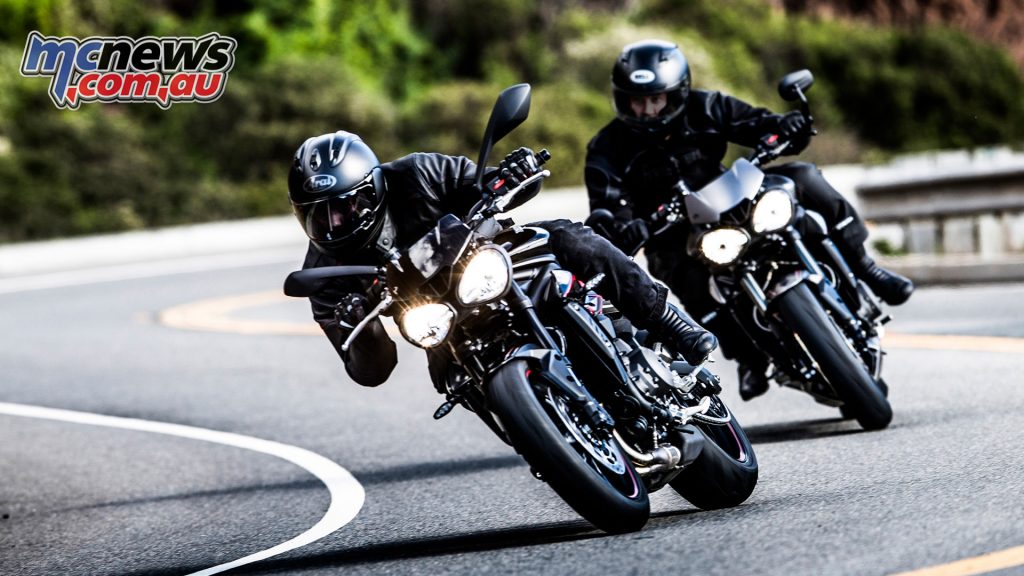
Having been given permission to play the ‘lad’ I rolled off at the top of the hill, grinning like a man on a promise, and then very diligently ambled home, keeping the group safe and sound. So why do I find this bike so good?
It’s quite compact, it feels like a bike you own, not the other way around, with razor sharp handling and control in every configuration – it just begs to be ridden. Yes, the seat is firm, but the suspension system is exhaustively able. It is amazing how comfortable predictable behaviour becomes under load.
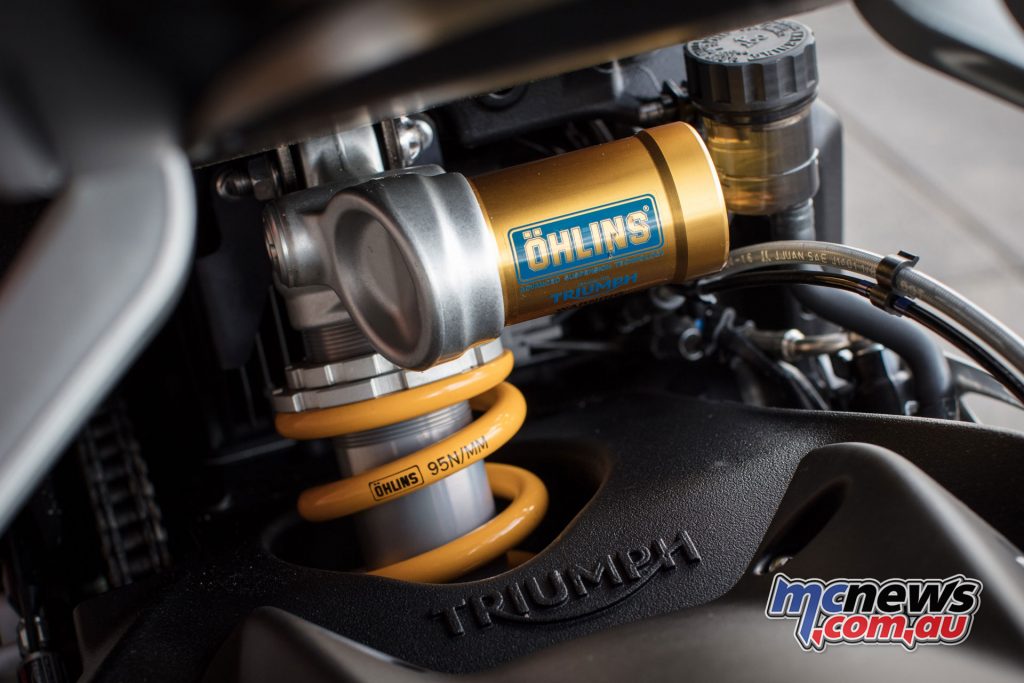
Up front, Showa’s 41mm upside-down forks give 115mm of front wheel travel, while offering adjustable rebound and compression damping, and adjustable preloading as well. Steering geometry, to my feel, is steep and quick as hell, the RS loves the corners and it flicks from side to side like the track pedigree the RS designation suggests.
In the rear the Ohlins piggy back reservoir monoshock gives 131mm of travel. Adjustable lock rings give preload adjustments, with compression and rebound damping adjustable as well.
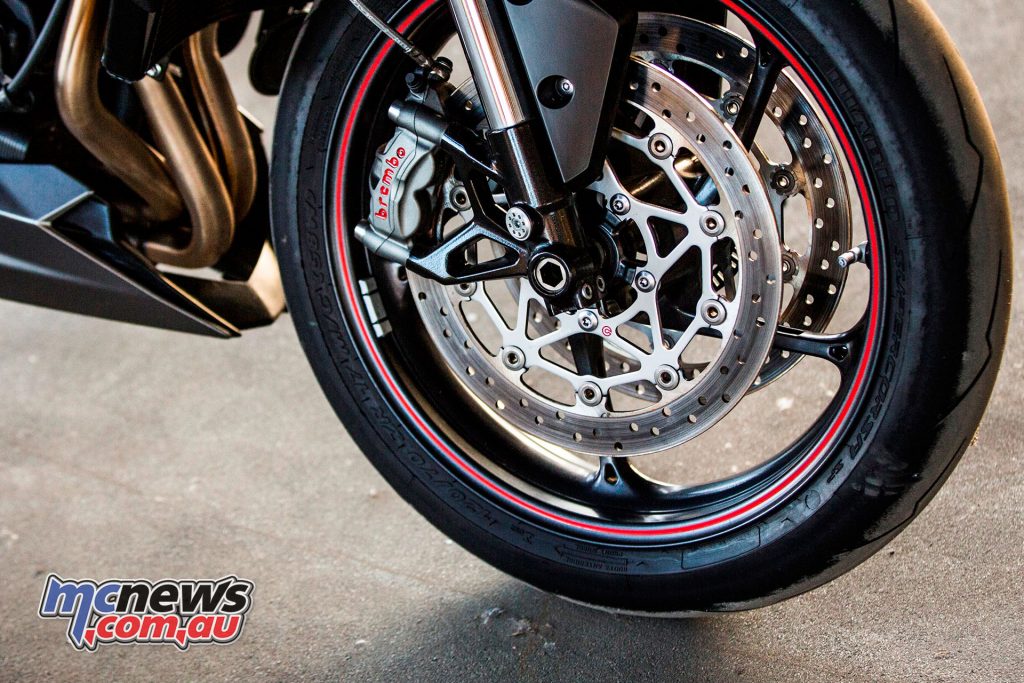
Anchoring is controlled by new Brembo Monobloc M50 four-piston calipers and twin 310mm discs on the nose, and at the rear by a 220mm disc with Brembo caliper, both with switchable ABS. Face-ripping traction in the dry is standard.
Instrumentation is also up-to-the-minute trick and smart, with a five-inch auto contrast TFT big screen, and the menus are some of the most intuitive around.
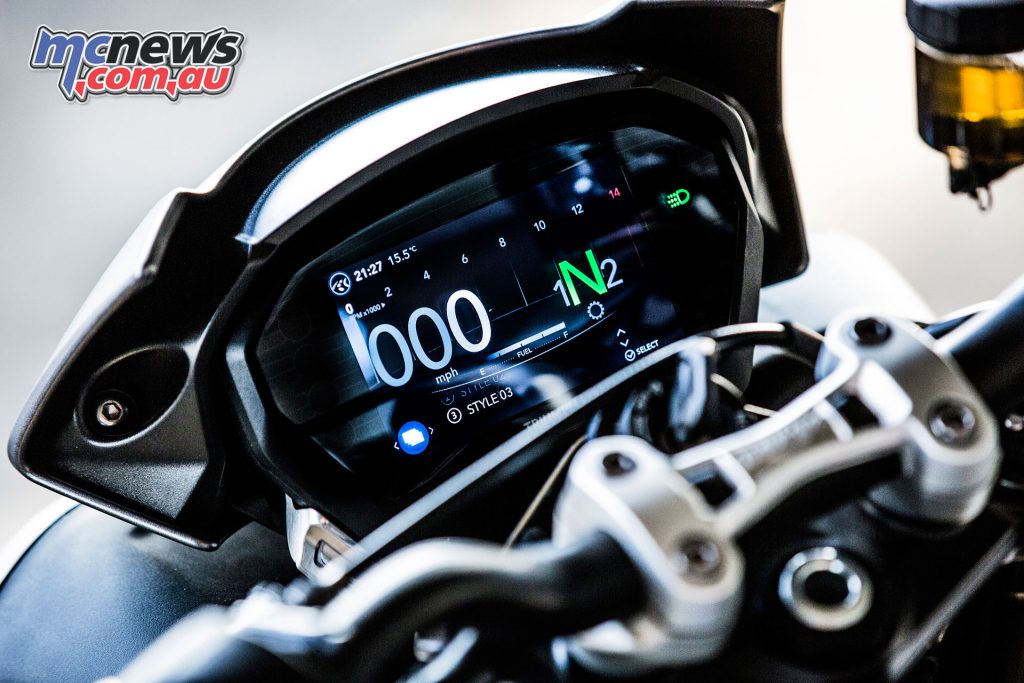
Access to these comprehensive menus is via the HOME button on the right handlebar and controlled via a five-way switch on the left handgrip; forward, backward, up and down, and push in for select. Pushing the home button brings up the first screen and the main menu with a list of riding modes; bike set-up, trip set-up, display set-up, lap timer and reset to default.
Riding modes offer five settings with selectable attributes; RIDER (manually set) with choices made by rider of Traction Control, Map setting and ABS, plus RAIN, ROAD, SPORT and TRACK preset modes.
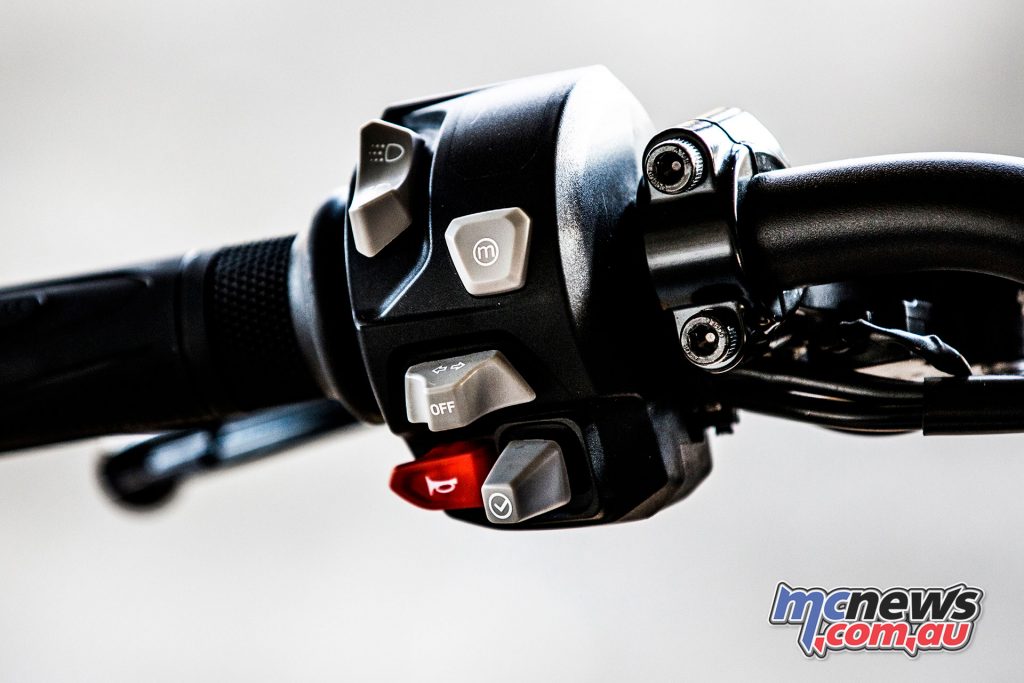
All these options have variable choices but the main selections set the bike up with superb presets. Selecting them is as easy as pushing the M button on the left handlebar and choosing the pictured road, track or rain element with the selector switch. It’s a lot easier than this sounds!
Display settings. There are three themes to the display that deliver various styles of rev, speed, gear, time, trip, fuel and so on, and three configs within each theme. The auto-contrast changes between black background in darker conditions and at night, and white background in brighter daylight.
This modern and user friendly interface lets you control, ABS, traction Control and mapping right in front of you and is simplicity itself to negotiate. Some serious thinking has gone into a state of the art interface for this bike.
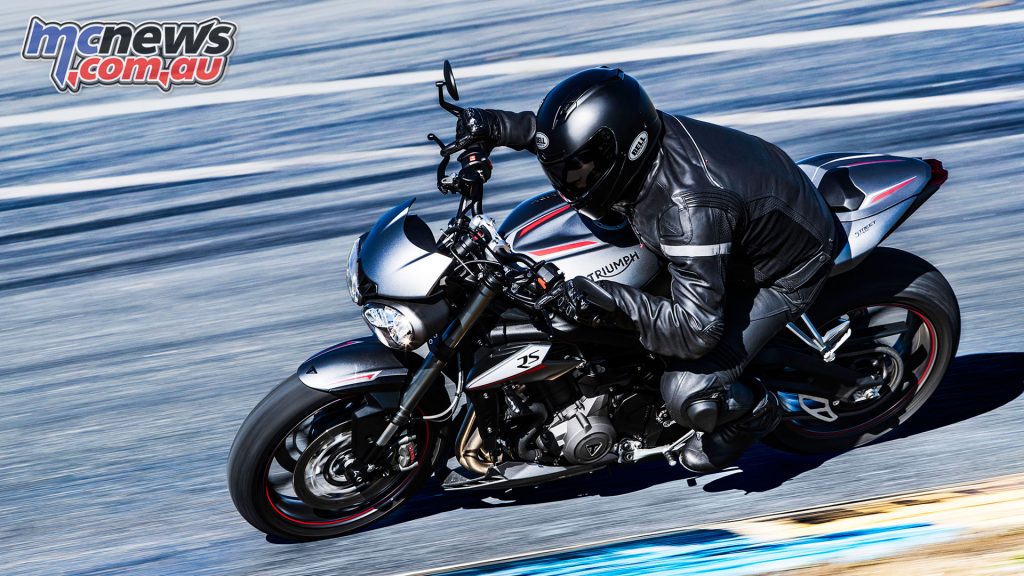
I love the semi naked look of this bike – with just enough fairing to give a street bike thrill. The finish is second to none, even the double rows of white stitching in the seat remind me of a winding roadway beckoning me forward.
Riding position for the taller rider is surprisingly good and I found myself hugging the tank with my thighs and feeling snug as a bug on board. The rake of the small screen is enough to be barely noticeable but still deflects the slipstream overhead, and I remained surprisingly free of buffeting even at high speeds.
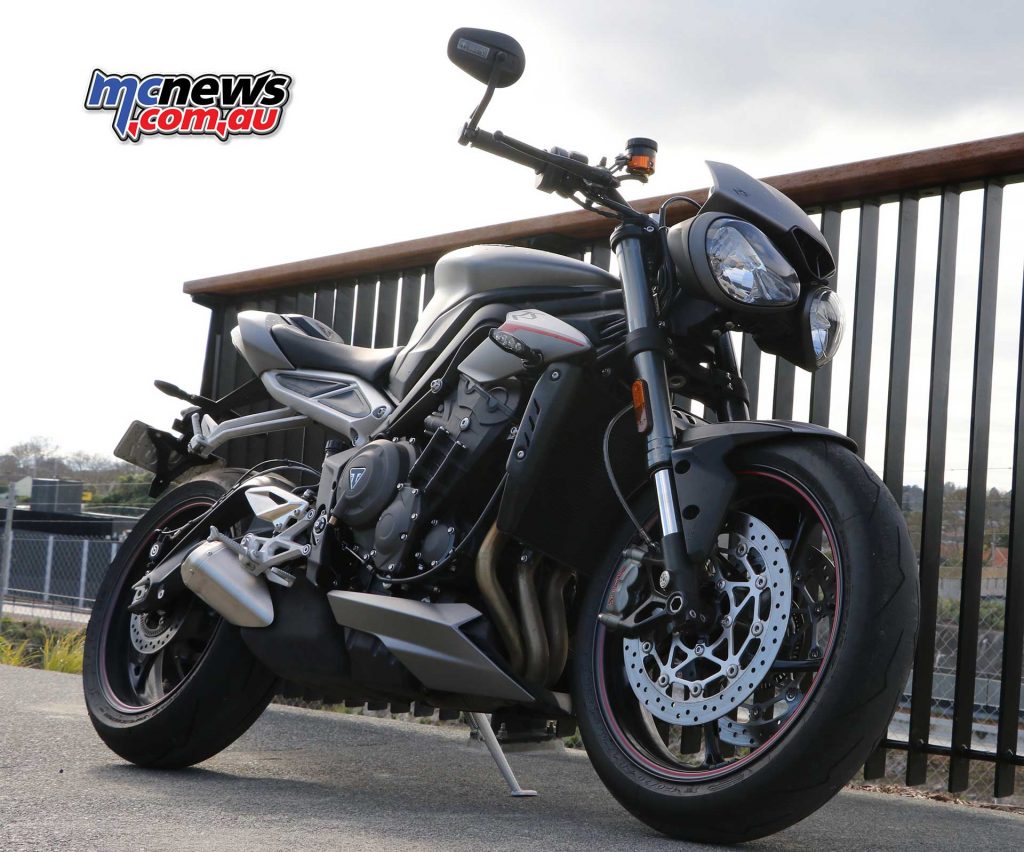
Paint, plastics, graphics, finish and feel are top of the line excellent, (it was reminiscent of the level of finish in top end BMW’s) and to my eye very appealing. There are very, very few bikes I would consider fitting in the garage alongside my beloved T120, (it’s a very small space), but I enjoyed this bike so much, I almost felt I was cheating on my wife.
There was one issue which took me a couple of rides to figure out, and it seemed to be a problem until I got my head round it. Very simply, if, while riding along, I put upward pressure on the gear-shifter prior to rolling off the throttle and changing clutchlessly, the bike would hiccup. For all the world like an ‘out of gas’ sputter. Realising that I was causing the issue made me stop preloading the selector (and quickshifter which cuts ignition) and the problem abated.
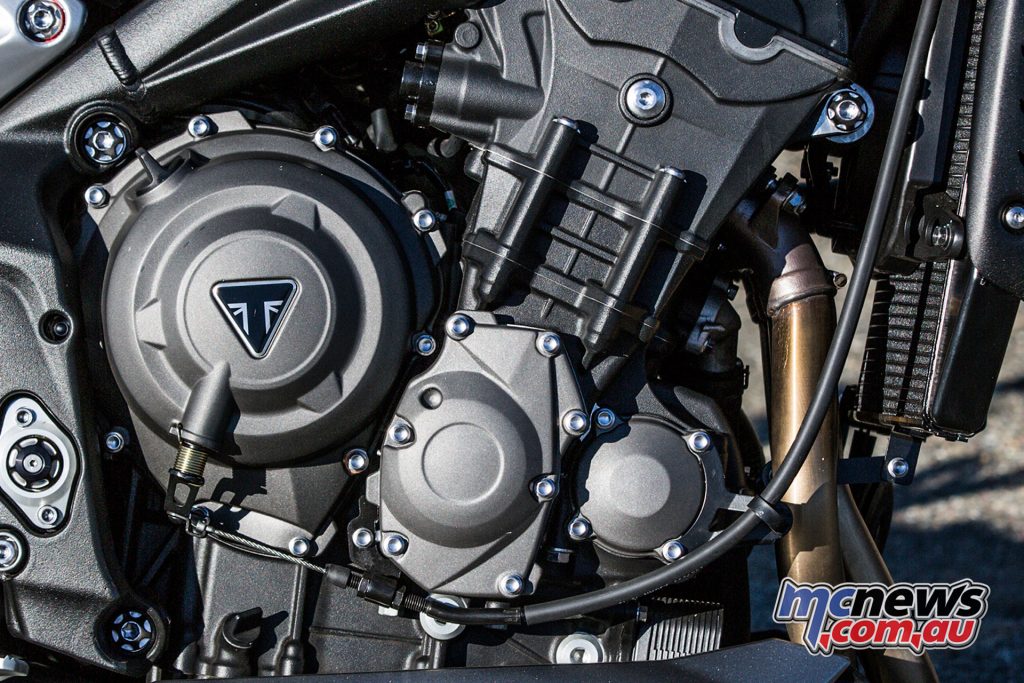
Obviously the engine accommodates the quick-shifter gear change with that hiccup, but its almost unnoticeable in proper use. But I was used to loading the gear lever prior to snap-rolling off the throttle, and it took a couple of rides to accommodate this system in my riding.
Frankly, Triumph has hit it out of the park with the 765 RS, and this engine has been picked to power the Moto2 racers from 2019 onwards. Why? The stock output of the new 765cc Triple is 121hp @11,700rpm, with more than 80 new parts.
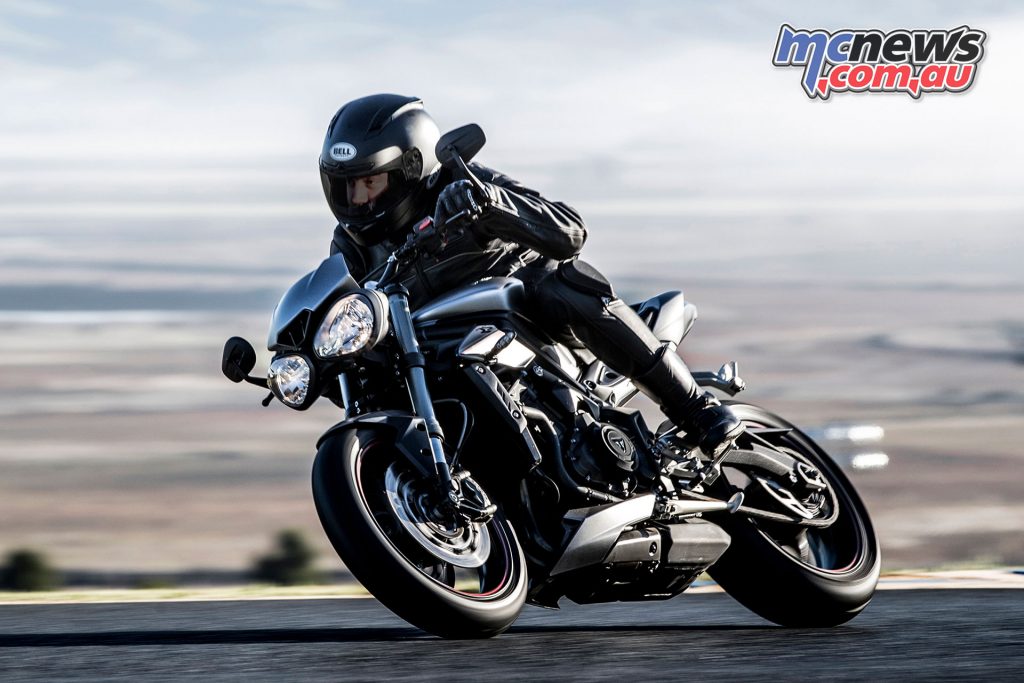
The engine has a new crank with longer stroke, new pistons, rods and Nikasil plated cylinders, and a revised gearbox. Triumph’s press release tells us that its Moto2 race engines will be, “…tuned for a major step up in power and torque,” and a look at the numbers suggests 140hp as likely. Crikey. Leaving the Honda 600 behind seems like a major step up.
I started by saying that reviews are often unrelentingly positive, that the bar is constantly being elevated. The Triumph 765 Street Triple RS is a blindingly fine leap forward and that bar has been shoved in the face of every other manufacturer out there.
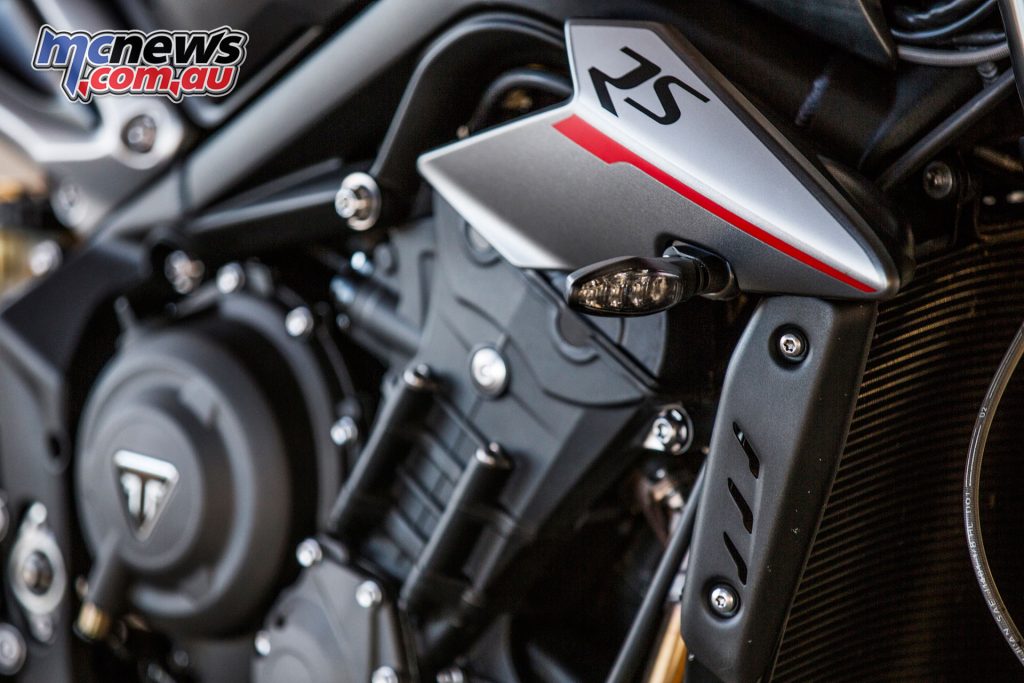
To deliver this level of smarts, this level of factory race ability, and at the top end of quality, is leading by example. To do it at the price point Triumph has, is to throw down a gauntlet that will take major cojones for any rival to pick up.
Is it really that good? It is without doubt one of the most electrifying, powerful, agile, light,and thrilling motorcycles you can ride on road and track. So, yes. Yes, it f***ing well is!
Triumph Street Triple 765 RS Strengths and Weaknesses
- Plus – Power; agility; a complete package.
- Minus – Not much weather protection – but it is a naked.
Street Triple 765 Model Overview – S, R, RS
For 2017 Triumph unveiled the new Street Triple, boasting a new Daytona derived liquid-cooled 765cc triple-cylinder DOHC powerplant, with four valves per cylinder, a bore and stroke of 78 x 53.4mm and electronic throttle control, or RbW as it is commonly known, allowing the addition of an extensive electronics package. A revised airbox and gearbox, with shorter first and second gears also features.
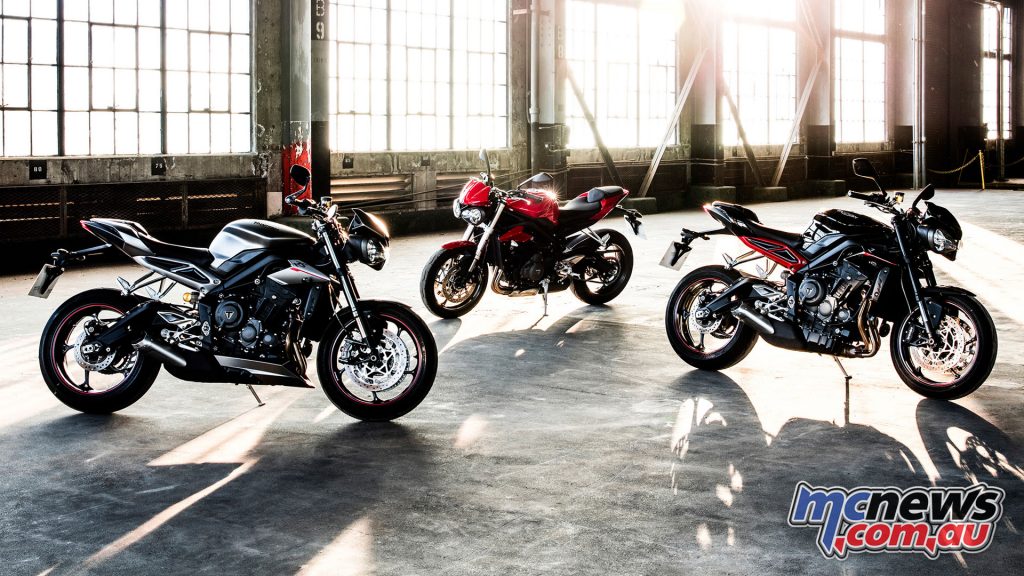
Other additions to the new models, apart from the all-new powerplant, included new Showa suspension and upgraded brakes varying between the models, an all new exhaust system, and new gullwing swingarm. Styling was also revamped, with Triumph boasting a higher quality of finish, alongside the new bodywork and seat. Headlights are also now a teardrop shape, while an instrument cowl is standard fitment.
Three unique (claimed) power outputs are also found across the three models. The standard S model offers 113PS at 11,250rpm, while the R features 118PS at a peakier 12,000rpm and the RS (as tested) offers 123PS at 11,700rpm. Torque also varies between the models, with the S offering 73Nm at 9100rpm, while both the R and RS offer 77Nm, at 9400rpm, and 10,800rpm respectively.
The electronics package offers up to five riding modes, with the full five found on the RS, including multi-level traction control, switchable ABS, and control of additional features via the dash, such as the self cancelling indicator settings.
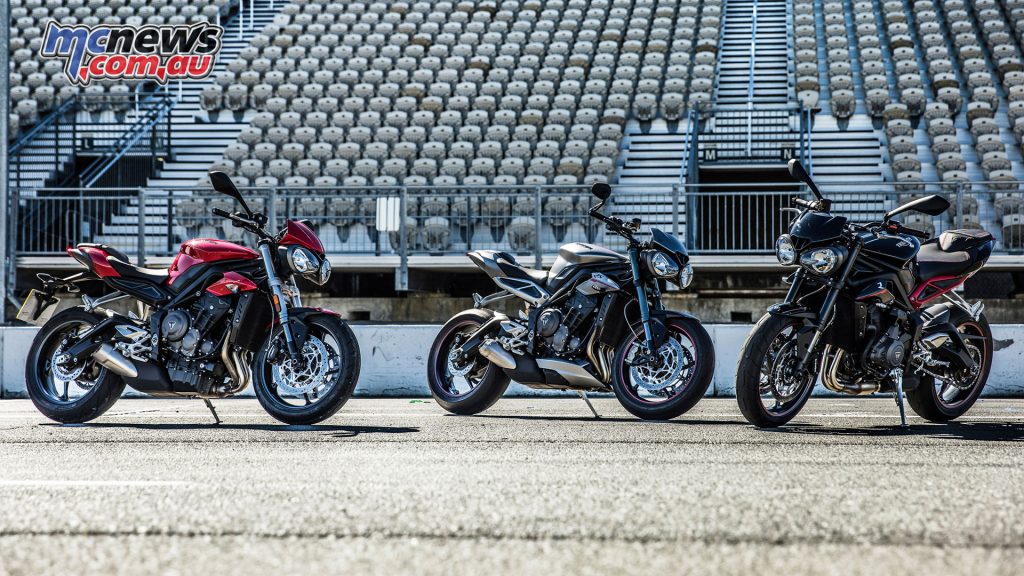
Each model also offers distinct suspension and braking performance, with the S including Nissin two-piston front calipers, Showa USD separate function forks, and preload adjustable rear monoshock, while the R includes Brembo M4 four-piston monobloc calipers and Showa fully adjustable Separate Function Big Piston (SF-BPF) forks, with a Showa monoshock.
The RS includes M50 four-piston monobloc calipers, ratio and span adjustable brake lever, as well as Showa fully adjustable Big Piston (BPF) forks with a Ohlins STX40 monoshock. The S and R models are fitted as standard with Pirelli Diablo Rosso Corse tyres, with the Diablo Supercorsa SP found on the RS.
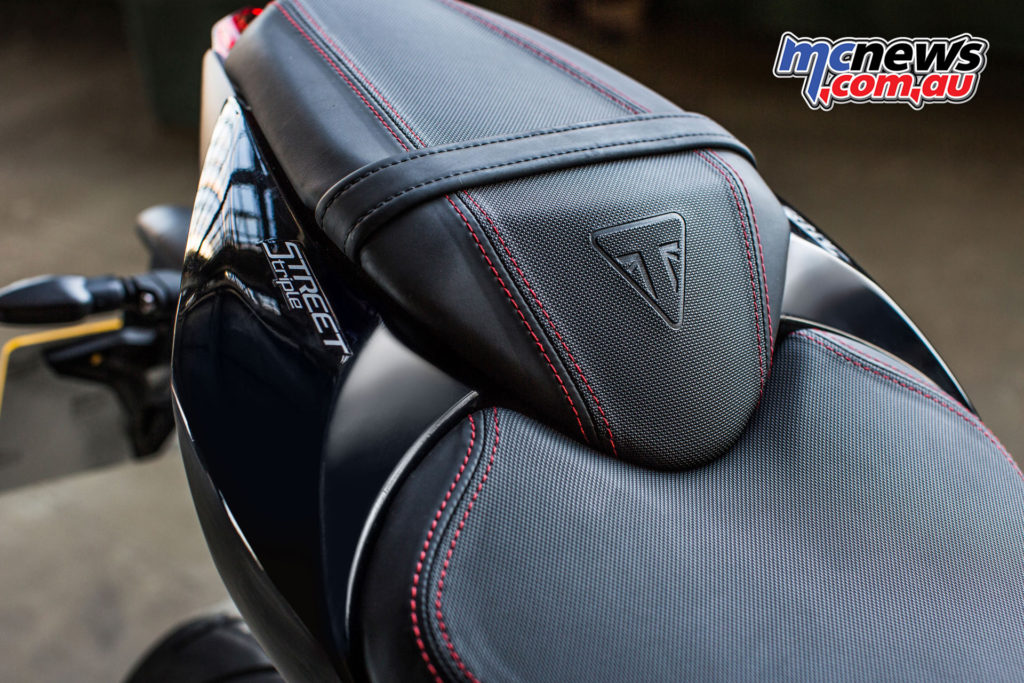
Additional features found on the R and RS models include a slipper clutch, 5inch TFT display, near switchgear with joystick, Daytime Running Lights (DRL) and additional rider modes over the standard S model. The S model only offers Road and Rain modes, and offers an LCD display.
The RS alone also features a quickshifter as standard, and a lap timer.
The S model also stands out for offering an 810mm seat height compared to the R and RS’s 825mm, as well as a rake of 24.8 degrees compared to 23.9, with a trail of 104.3mm compared to 100mm.
The RS comes standard with a matched bellypan and pillion seat cowl, with Triumph claiming the computer powering the R and RS is higher specification than that found on the S.
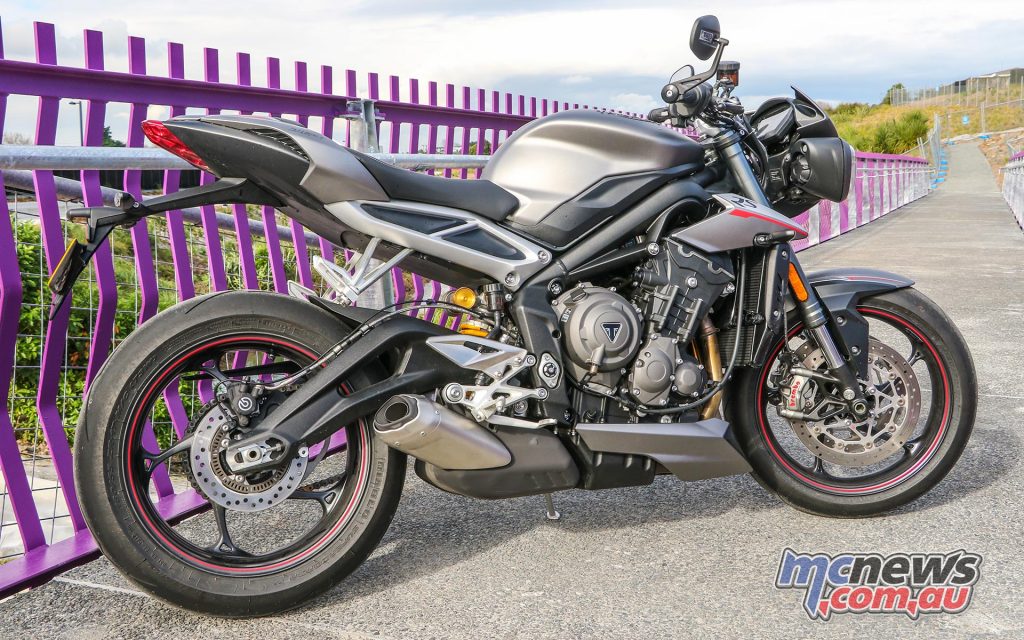
Triumph Street Triple 765 RS Specifications
- Engine – 765cc, liquid-cooled, DOHC, 12-valve, three cylinder four-stroke
- Bore x stroke – 77.99 x 53.38mm
- Compression – 12.65:1
- Power (claimed) – 90.4kW (121.2bhp) @ 11,700rpm
- Torque (claimed) – 77Nm @ 10,800rpm
- Starter system – Electric
- Ignition – Digital electronic
- Fuelling – Electronic fuel injection
- Clutch – Wet, multi-plate, slipper-type
- Transmission – Six-speed, chain
- Frame – Aluminium beam twin spar
- Swing-arm – Two-sided aluminium
- Front suspension – Inverted 41mm Showa BPF-type telescopic fork, compression and rebound damping, spring preload adjustment, 115mm travel
- Rear suspension – Ohlins STX40 monoshock, compression and rebound damping, spring preload adjustment, 131mm travel
- Brakes front – 310mm twin floating discs, Brembo M50 four-piston monobloc calipers, switchable ABS
- Brakes rear – Single 220mm disc, Brembo one-piston caliper, switchable ABS
- Wheels – Cast aluminium, five spoke
- Tyres – 120/70 ZR17 front; 180/55 ZR17 rear
- DIMENSIONS
- Seat height – 825mm
- Wheelbase – 1410mm
- Rake/trail – 23.9°/100mm
- Weight (dry) – 166kg
- Fuel capacity – 17.4 litres
- Price – $17,550 + ORC
- Contact – Triumph Motorcycles Australia; www.triumphmotorcycles.com.au























